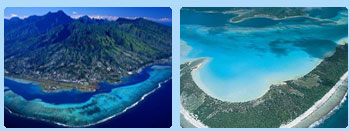|

• Cook Islands
• Fiji
• Tahiti
Tahiti

Just 7 1/2 hours from Los Angeles, you'll find the crystal
clear turquoise lagoons and pristine beaches of the islands
where love lives. Tahiti and Her Islands comprise an area
officially known as French Polynesia. The Islands are scattered
over four million square kilometers (one and a half million
sq. miles) of ocean in the eastern South Pacific.
The total land area of these 118 islands and atolls adds
up to only 4,000 sq. km. (1,544 sq. miles), and consists
of five achipelagoes: the Society Islands, Austral Islands,
Marquesas Islands, Tuamotu atolls and the Mangareva Islands.
The population of French Polynesia is an amalgam of Polynesian
(75 percent), Chinese (10 percent), and European (15 percent).
Among these racial categories exists every conceivable mixture.
It would not be unusual to encounter a Tahitian of Chinese,
American, Polynesian and French ancestry. The term French
Polynesia refers to five archipelagoes spread over an expanse
of the South Pacific approximately the size of Western Europe
(2,000,000 square miles or approximately 5,000,000 square
kilometers). The region includes the Marguesas, the Tuamotus,
the Society Islands, the Australs and the Gambiers. Each
of these archipelagoes has its own culture, ethnicity and
climate.
French Polynesia was the natural backdrop for the legendary
paintings of Paul Gauguin. Like the vast majority of visitors
to the region, Gauguin has inspired by French Polynesia's
turquoise lagoons, multi-coloured reef fish, volcanic peaks,
lush valleys and white-sand beaches.
Tahitian culture is a lively fusion of ancient Polynesian
lore and European contemporaneousness.
The mixture of Polynesian and French cultures has resulted
in a fertile culinary environment. There is a variety of
splendid foods available in Tahiti ranging from traditional
Tahitian fare to fine French cuisine, and tempting combinations
thereof. The Tahitian diet consists mostly of fish, shellfish,
breadfruit, taro, cassava, pork, yams, chickan, rice and
coconut.
Visitors will also find any number of Italian, Vietnamese
and Chinese restaurants of various price categories and
quality. For Americans accustomed to fast-food, Papeete
and some of the outer islands serve hamburgers, steaks,
fries and similar staples.
In terms of art and culture, upper-class Tahitians have
adopted western pop culture. French Polynesians wear the
most chic fashions, listen to the latest pop music and drive
the latest Bavarian cars and Japanese automobiles. Yet despite
this obvious affection for Western style, the proud people
of French Polynesia still have their own language and customs.
The area has inspired a host of legendary artistic works.
Tahiti has captured the imagination of European intellectuals
and artists ever since Rousseau waxed about the "Noble
Savage." French Polynesia was the setting for Herman
Melville's groundbreaking book, "Typee," which
was the first novel about a romance between a white man
and a Polynesian native. The region was also the inspiration
for the popular theatre production, "Bali Hai."
Perhaps the most popular and influential artist to be associated
with Tahiti is painter Paul Gauguin, whose earth-hued portraits
of Polynesian life are world-renowned.
Arguably, the most resilient aspects of Polynesian culture
are music and dance. Traditional percussionists offer one
of the purest expressions of Polynesian music and are as
much a part of the music scene today as are electric guitarists
(percussionist always accompany dance troupes). Tahitian
music has evolved into a fiery mix of Polynesian melody
and rhythm and American pop, Jamaican reggae, French chansons
and even hymns borrowed from the missionaries.
Crafts are an important part of the cultural picture in
French Polynesia. Traditional mat or basket weaving and
carving are still practiced in the more remote areas, such
as the Marguesas, Tuamotu and Austral islands. The Australs
in particular, are famous for the quality of mats and hats
woven from Pandanus, a tree that grows throughout the South
Pacific. Carvings and wood sculptures are produced mostly
in the Marquesas Islands.
Polynesia is the birthplace of the tattoo, and this internationally-recognized
form of body painting has been practiced here since ancient
times. It's almost impossible to walk down a busy thoroughfare
in Papeete or Moorea without encountering tattooed locals.
The Islands:
Tahiti:
Often called "The Queen of the Pacific," Tahiti
is the largest of the islands. Home to mountain waterfalls,
beautiful beaches and the capital city of Papeete, its effect
on visitors is magical.
Moorea:
Often likened to James Michener's mythical island of Bali
Hai, Moorea is marked by volcanic peaks reflected in the
tranquil waters of its two signature bays.
Bora Bora:
Bora Bora's main island sits like a jewel in the center
of its legendary multi-colored lagoon, which is surrounded
by off-shore islets inside a protective necklace of coral.
Huahine:
Comprised of two islands joined by a small bridge, Huahine
boasts watermelon and cantaloupe gardens on its offshore
islets, and bustling Chinese shops along its waterfront.
Raiatea- Tahaa:
Only two miles apart and surrounded by the same barrier
reef are Raiatea - the second largest Tahitian island, once
the center of Polynesian culture - and tranquil Tahaa, often
called the "Vanilla Island," for the delightful
scent of its plantations.
Rangiroa:
Travelers searching for the perfect secluded getaway need
look no farther than Rangiroa: cycle around the island,
snorkel the magnificent lagoon, or just relax in a luxurious
resort.
Manihi:
Peaceful, quiet Manihi boasts several black pearl farms
and a crystal clear lagoon more than three miles wide and
19 miles long.
Marquesas:
From the fantastic skyline of Ua Pou to the desert-like
plateau of Ua Huka, the islands of the Marquesas archipelago
are far from the beaten track, with a beauty matched only
by their serenity.
Austral:
Hundreds of miles to the southwest of Tahiti lie the Austral
islands. From the limestone grottoes of Rurutu to the near
isloation of far off Rapa, these islands offer an exotic
paradise for the most adventurous explorers.
Mangareva:
With its gently rolling hills and Mediterranean climate,
Mangareva, the largest isle in the Gambier archipelago,
well deserves its title as a "Garden of Eden."
|

